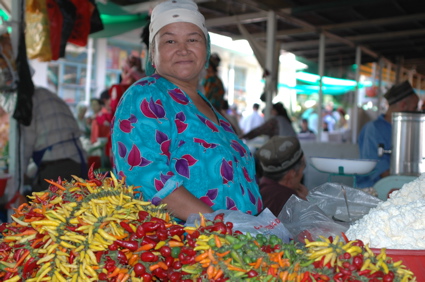Ed Bruske recently spent a week in the kitchen at H.D. Cooke Elementary School in the District of Columbia observing how food is prepared. This is the first of a six-part series of posts about what he saw. Read parts 2, 3, 4, 5, and 6. Cross-posted from The Slow Cook. And check out the rest of the Cafeteria Confidential series.
 The lunch menu said chicken patty on a bun, but there was a problem: ingredients for the week had never been delivered. Tiffany Whittington, food service manager at H.D. Cooke Elementary School, conducted a quick mental inventory of ingredients she had on hand and decided to improvise lunch for the school’s 326 students.
The lunch menu said chicken patty on a bun, but there was a problem: ingredients for the week had never been delivered. Tiffany Whittington, food service manager at H.D. Cooke Elementary School, conducted a quick mental inventory of ingredients she had on hand and decided to improvise lunch for the school’s 326 students.
She opened the door to the walk-in freezer and grabbed several 5-pound bags of something called “beef crumbles,” then pulled a 10-pound box of curly egg noodles and two 6-pound cans of tomato sauce off a shelf in dry storage. The pre-cooked “beef crumbles” would be heated in a steamer; the egg noodles as well. Then Whittington would slather the beef with the canned tomato sauce, spice it up with a little garlic powder, and finally stir in the noodles and some pre-shredded cheese.
Voila: “Baked ziti!” Whittington declared.
So began my week as an observer in the kitchen at H.D. Cooke in Adams-Morgan, the school where my 10-year-old daughter attends fourth grade. I was anxious to see how the kitchen operated because until recently, school meals in the District of Columbia had been made offsite by an industrial vendor and sent to the schools pre-cooked in individual plastic packaging. It was kind of a sorry sightpa, watching kids line up for those plastic-sealed packages — too much like airline food.
The food service operator for D.C. Public Schools, Chartwells-Thompson, decided to ditch the plastic meals and replace them with something called “fresh cooked.” Under the new regime, D.C. students would eat food prepared in their school’s own kitchen, or, if the school didn’t have a kitchen, at the nearest high school and delivered.
This sounded like a step back to the future, more like a time not too distant when school meals were made from scratch mostly by ladies who knew something about cooking. In the case of H.D. Cooke, it meant a brand new kitchen as well. The school recently underwent a multi-million-dollar renovation, including the addition of a full-scale commercial kitchen with walk-in freezer and refrigerator, gleaming stainless steel pot sinks and work tables, and lots of brand new equipment. There’s a huge hood with fans in the ceiling to ventilate a double Blodget convection oven and a set of Cleveland commercial steamers. A Winston holding cabinet keeps food warm after it’s been cooked.
Presiding over the operation is Whittington, a Ballou High School graduate who took a job with D.C. Schools in 2001 after finishing a course in food service. Cooking out of a real kitchen was a change for her. “They just gave me a recipe book and said, ‘Here you go!’ So here I am.”
Over the next few days I’ll be describing in detail what “fresh cooked” means. One of the first things you notice in the kitchen at H.D. Cooke is a big empty space under the ventilation hood where a cooktop and range would be. Whittington explains that a stove has been promised for some unspecified date in the future. But the way food is prepared in D.C. schools, a cooktop — an appliance most of us would consider essential in our home kitchens — is completely unnecessary. There are no pots to boil water or cook food in. That’s all done in the steamer using stainless steel pans.
Since nearly all of the ingredients for school meals in the District arrive frozen or canned, and in many cases already cooked, they are quickly prepared in the convection oven or in the steamer. Some things, such as the “cheese sauce” used on lunch nachos, aren’t even removed from the plastic bags they arrive in before they are heated in the steamer. They are then emptied into a stainless pan and placed directly on the lunch counter to be served.
The system is precisely designed for optimum efficiency, convenience, and economies of scale. As I discovered during my week in the H.D. Cooke kitchen, “fresh cooked” — the food our children are served here in the nation’s captiol every day — is a perfect reflection of the prevailing industrial methods that rule our nation’s food supply. Meal components are highly processed and reconstituted, some with ingredients provided by the U.S. Department of Agriculture’s commodities food program, and come from factories all over the country. Human intevention has been reduced to an absolute minimum. It’s cheap, it’s fast, and it’s easy. Whittington and her two assistants spend more time serving and cleaning up than they do actually preparing the food.
The cooking regime has been so simplified, I can’t help asking Whittington what she did with her time before the advent of “fresh cooked,” when all the meals arrived pre-assembled in packages. “We had to warm it up,” she replied.
What’s missing are fresh, whole ingredients. Children receive fresh fruits and vegetables as morning snacks. Sometimes salad is served in the lunch line, and occasionally whole fruits are offered with lunch. But this represents a world of difference from the food service Mattie Hall remembers. Nearing retirement, she now assists Whittington. “In the ’80s we did it all,” she says. “Grits, sausage, pancakes. We made bread rolls from scratch, baked in the oven.”
Also missing is flavor. “I don’t like most of the food because it doesn’t taste good,” says my daughter. Still, Whittington serves about 280 lunches each day, most of those fully subsidized by the federal government to the tune of $2.68 per meal. D.C. schools offer free breakfast to all students. About 150 children at H.D. Cooke participate. In all, Chartwells feeds about 30,000 of the approximately 40,000 students enrolled in the the D.C. Public Schools system on any given day, making it the biggest feeding program in the city. Another 20,000 students attend public charter schools, which hire their own food providers, usually small catering companies.
Most of the children at H.D. Cooke qualify for free lunch based on family income. Some qualify for partially subsidized meals. A few must pay. They have accounts with the kitchen that they occasionally pay into. Money rarely changes hands in the food line, but in order to keep accounts straight and collect the federal reimbursements, Whittington must keep careful track of who is taking meals. She sits at one end of the food line with her computer, making a note of each student with a click of her mouse. “I know every kid in the school — unless they’re new,” she says.
Based on the number of needy students Whittington serves, the school also qualifies for donations of commodity foods — meat, poultry, cheese, for instance — from the U.S. Department of Agriculture. The school system uses the donations like credit to purchase finished food products from suppliers, which helps hold down costs.
When I first arrived at the H.D. Cooke cafeteria, or “Kid’s Stop Cafe,” breakfast was just ending. Slices of French toast — delivered cooked and frozen, then reheated — were displayed on the steam table. There were also individually packaged “whole grain” strawberry-flavored Pop Tarts available, as well as individually packaged Goldfish “Giant Grahams,” fruit mix from a can, and a choice of four milks in eight-ounce (one cup) containers: regular low-fat, regular non-fat, chocolate and strawberry-flavored.
Meanwhile, back in the kitchen, Whittington was preparing vegetables for lunch. The mix of green beans and lima beans, corn, and carrots had arrived at the school frozen. It was then placed in the steamer, a unit that looks like a windowless stacking oven, but circulates steam to heat and cook food. Into the vegetables Whittington stirred scoops of “Smart Balance Buttery Spread.” According to the label, it was made of a “blend of palm fruit, soybean, canola and olive oils” plus “natural and artificial flavors” and “beta carotene color.”
She then started on her “baked ziti.”
At first I couldn’t tell what the “beef crumbles” were, even though they were plainly visible in their plastic packaging. They look like Sloppy Joe mix without the sauce. But because of their dull, greyish-brown color, I first thought of baker’s chocolate. Reading the label, I saw that the contents were in fact “beef, vegetable protein, caramel color” along with a list of chemical flavorings and preservatives. It came from a company in Cincinnati, Ohio, and was supplemented with “USDA commodities.”
The canned spaghetti sauce was made by Giovanni Food Co. in Liverpool, N.Y. It was not as red as the spaghetti sauce I am used to and I found the pale color a bit odd and off-putting. The label said it contained “tomato paste, dextrose/and or high fructose corn syrup, potato or corn starch.” Perhaps what it needed was more tomato.
After mixing the beef, the sauce, the noodles and some garlic powder, Whittington added two cheeses: Land O Lakes brand shredded mozzarella and shredded cheddar from five-pound bags. Whittington gently stirred the mix again with her gloved hands, then into the holding cabinet it went. Whittington said she likes to add cheese to a lot of the food she serves because it adds flavor. “I think the kids really like it.”
Rounding out the day’s lunch menu: Del Monte diced peaches from six-pound cans, sweetened with corn syrup. As you will see in the days that follow, there’s one thing beside cheese the kids at H.D. Cooke are rarely lacking: sugar.
Next: How industrial methods make school food fool-proof and cheap.




